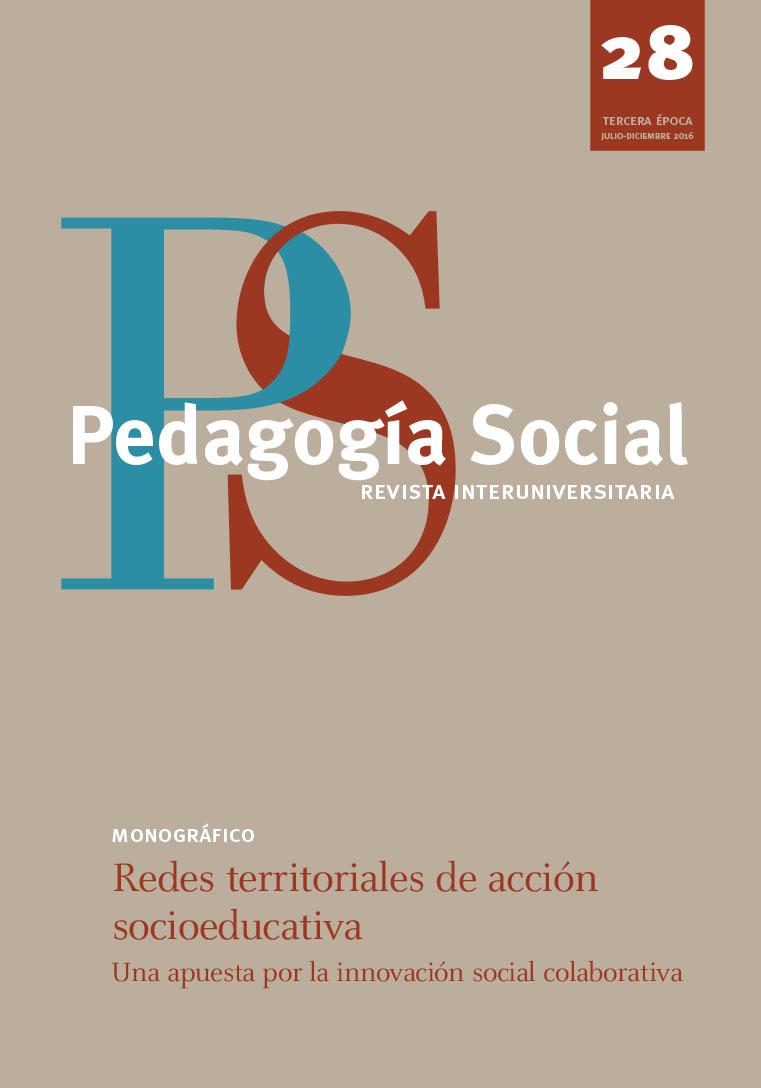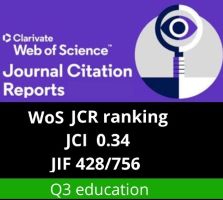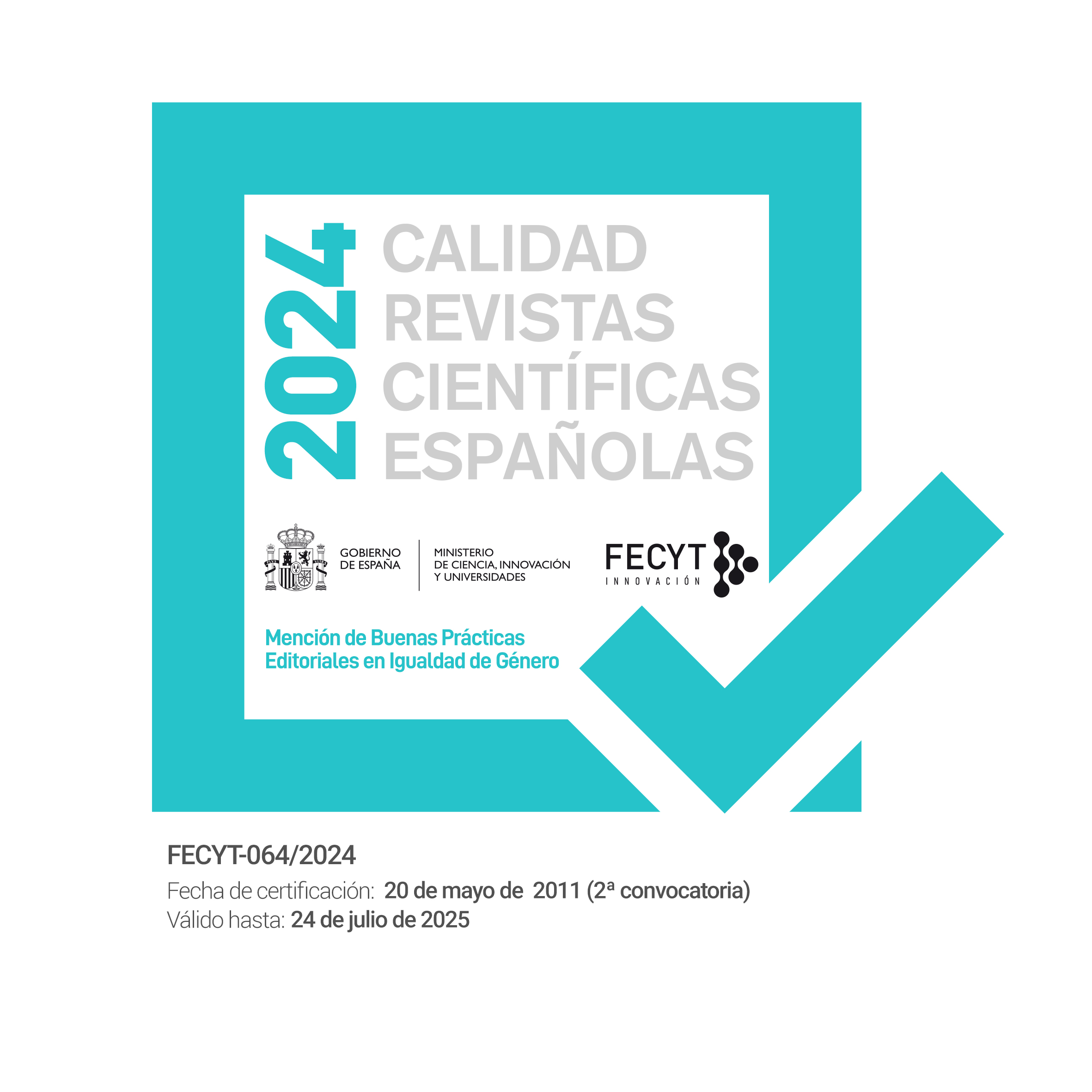Difusión de la innovación: la red social y el enfoque de aprendizaje organizativo para la gobernanza de un equipo de liderazgo de todo el distrito
DOI:
https://doi.org/10.7179/PSRI_2016.28.04Palabras clave:
redes sociales, clima innovador, aprendizaje organizacional, gobernanza, liderazgoResumen
Los líderes de distrito y las escuelas son esenciales para liderar las mejoras de todo distrito, ya que cada vez generan más cambios y mejoras para la innovación educativa y la excelencia. Mientras que la gobernanza del distrito convencional se centra básicamente en cuestiones técnicas y administrativas como el desarrollo de políticas, supervisión y el seguimiento del progreso, en muchas ocasiones este enfoque técnico deja de lado la base que impulsa a la mejora: la infraestructura social formada por las relaciones interpersonales. En respuesta a los últimos itinerarios universitarios que reclaman una aproximación en red a la gobernanza, este estudio examinó el esfuerzo de cambio de un equipo directivo de un distrito en momentos en el tiempo basándose en la teoría de redes sociales y el análisis centrado en la gobernanza del distrito. Nos centramos principalmente en el tipo de relación interpersonal con líderes comprometidos para compartir e intercambiar ideas innovadoras y cómo estos esfuerzos pueden apoyar una mejor gobernanza. Además, se analizó el aprendizaje organizacional como una forma de examinar el clima para apoyar los esfuerzos innovadores de todo el distrito durante el proceso de cambio. Los resultados que extrajimos de los líderes indican que con el paso del tiempo se produce un incremento de comportamientos innovadores y una mejora del clima percibido en un aprendizaje organizacional. Los resultados sugirieron que con el tiempo los líderes incrementaron las conexiones asumiendo riesgos, independientemente de su nivel de trabajo. Esta creciente conectividad en innovación coincidió con un aumento en la percepción del clima de aprendizaje del distrito por parte de los líderes, lo que sugiere una aproximación coherente a la gobernanza y mejora.
Descargas
Citas
Alsbury, T. L. (2003). Superintendent and school board member turnover: Political versus apolitical turnover as a critical variable in the application of the dissatisfaction theory. Educational Administration Quarterly, 39(5), 667-698.
Anthes, K. (2002). School and District Leadership. No Child Left Behind Policy Brief. D.C.: Education Commission of the States.
Argyris, C., & Schon, D. A. (1976). Theory in practice: increasing professional effectiveness. Adult Education, 27, 63-66.
Baker, W. (2014). Making pipes, using pipes: how tie initiation, reciprocity, positive emotions, and reputation create new organizational social capital. In D. J. Brass, G. Labianca, A. Mehra, D. S. Halgin, & S. P. Borgatti (Eds), Research in the sociology of organizations (pp. 57-71). Bingley, UK: Emerald Group Publishing Limited.
Boeck, D. (2009). Washington School board standards, benchmarks of success and indicators for evaluation, with references: A framework for effective governance. Washington State School Directors’ Association.
Borgatti, S. P. (2002). Netdraw network visualization. Harvard, MA: Analytic Technologies.
Borgatti, S.P., Everett, M.G., & Freeman, L.C. (2002). Ucinet 6 for Windows: Software for Social Network Analysis. Harvard, MA: Analytic Technologies
Brass, D. J., Galaskiewicz, J., Greve, H. R., & Wenpin, T. (2004). Taking stock of networks and organizations: A multilevel perspective. Academy of Management Journal, 47(6), 795-817.
Burt, R. S. (1992). Structural holes. Cambridge, MA: Harvard University Press.
Carpenter, D. P., Esterling, K. M., & Lazer, D. J. (2004). Friends, brokers, and transitivity: Who informs whom in Washington politics?. Journal of Politics, 66(1), 224-246.
Carver, J. (2000). Remaking governance. American School Board Journal, 187(3), 26-30.
Coleman, J. S. (1990). Foundations of social theory. Cambridge, MA: Belknap Press of Harvard University Press.
Cox, E. P. & Malone, B. G. (2001, October). Board/superintendent relations: A board perspective on superintendent searches. Paper presented at the meeting of the Mid-Western Educational Research Association, Chicago, iL.
Cross, R., Borgatti, S. P., & Parker, A. (2002). Making invisible work visible: Using social network analysis to support strategic collaboration. California Management Review, 44(2), 25-46.
Cross, R., Ehrlich, K., Dawson, R., & Helferich, J. (2008). Managing collaboration: improving team effectiveness through a network perspective. California Management Review, 50(4), 74-98.
Daly, A. J., & Finnigan, K. (2011). The ebb and flow of social network ties between district leaders under high stakes accountability. American Educational Research Journal, 48, 39-79.
Daly, A. J., & Finnigan, K. (2012). Exploring the space between: Social networks, trust, and urban school district leaders. Journal of School Leadership, 22(3), 493-530.
Daly, A. J., Finnigan, K., & Liou, Y.-H. (2014, April). Challenges, changes, and churn: A longitudinal social network perspective of urban district leadership. Paper presented at the annual meeting of American Educational Research Association. Philadelphia, PA.
Daly, A. J., Liou, Y.-H., & Brown, C. (accepted). Social red bull: Exploring energy relationships in a school district leadership team. Harvard Educational Review.
Daly, A. J., Liou, Y.-H., & Moolenaar, N. M. (2013). The principal connection: Trust and innovative climate in a network of reform. in D. Van Maele, P. Forsyth, and M. Vanhoutte (Eds.), Trust relationships and school life (pp. 285-312). Dordrecht, The Netherlands: Springer.
Daly, A. J., Liou, Y., Tran, N. A., Cornelissen, F., & Park, V. (2014). The rise of neurotics: Social networks, leadership, and efficacy in district reform. Educational Administration Quarterly, 50(2), 233-278.
Daly, A. J., Moolenaar, N. M., & Liou, Y.-H., Tuytens, M., & Del Fresno, M. (2015). Why so difficult? Exploring negative relationships between educational leaders: The role of trust, climate, and efficacy. American Journal of Education, 122(1), 1-38.
De Amorim S.G., Barthélemy, J.P., & Ribeiro C.C. (1990). Clustering and clique partitioning: Simulated annealing and tabu search approaches. Research report from Groupe d’études et de recherche en analyse des décisions. Ecole des Hautes Etudes Commerciales, Ecole Polytechnique, Université McGill.
Delagardelle, M. L. (2008). The lighthouse inquiry: Examining the role of school board leadership in the improvement of student achievement. in T. L. Alsbury (Ed.), The future of school board governance: Relevancy and revelation (pp. 191-223). Lanham, MD: Rowan & Littlefield Education.
Finnigan, K. S., Daly, A. J., & Che, J. (2013). Systemwide reform in districts under pressure: The role of social networks in defining, acquiring, using, and diffusing research evidence. Journal of Educational Administration, 51(4), 476-497.
Frank, K., zhao, Y., & Borman, K. (2004). Social capital and the diffusion of innovations within organizations: The case of computer technology in schools. Sociology of Education, 77(2), 148-171.
Galway, G., Sheppard, B., Wiens, J., & Brown, J. (2013). The impact of centralization on local school district governance in Canada. Canadian Journal of Educational Administration And Policy, (145).
Garvin, D. A., Edmondson, A. C., & Gino, F. (2008). is yours a learning organization?. Harvard Business Review, 86(3), 109-116.
Golarz, R. J. & Golarz, M. J. (1995). The power of participation: Improving schools in a democratic society. Champaign, iL: Research Press.
Howlett, M. (2014). From the ‘old’ to the ‘new’ policy design: Design thinking beyond markets and collaborative governance. Policy Sciences, 47(3), 187-207
Johnson, P. A. (2012). School board governance: The times they are a-changin’. Journal Of Cases In Educational Leadership, 15(2), 83-102.
Johnson, P. E., & Chrispeels, J. H. (2010). Linking the central office and its schools for reform. Educational Administration Quarterly, 46(5), 738-775.
Kilduff, M., & Tsai, W. (2003). Social networks and organizations. London: Sage.
Krackhardt, D., & Stern, R. (1988). informal networks and organizational crises: An experimental simulation. Social Psychology Quarterly, 51, 123-140.
Lin, N. (2009). Social capital: A theory of social structure and action (8th ed.). New York: Cambridge University Press. Liou, Y.-H. (2015). School crisis management: A model of dynamic responsiveness to crisis life cycle. Educational Administration Quarterly, 51(2), 247-289.
Liou, Y.-H., & Daly, A. J. (2014). Closer to learning: Social networks, trust, and professional communities. Journal of School Leadership, 24(4), 753-795.
Liou, Y.-H., Daly, A. J., Brown, C., & Del Fresno, M. (2015). Foregrounding the role of relationships in reform: A social net-
work perspective on leadership and change. International Journal of Educational Management, 29(7), 819-837.
Liou, Y.-H., Grigg, J., & Halverson, R. (2014). Leadership and the design of data-driven professional networks in schools.
International Journal of Educational Leadership and Management, 2(1), 29-71.
Looney, J. W. (2009). Assessment and innovation in Education. OECD Education Working Papers, 24. OECD Publishing. Luckin, D., & Sharp, L. (2004). Remaking local governance through community participation? The case of the UK community waste sector. Urban Studies, 41(8), 1485-1505.
March, J. G. (1991). Exploration and exploitation in organizational learning. Organization Science, 2(1), 71-87.
McLean, L. D. (2005). Organizational culture’s influence on creativity and innovation: A review of the literature and implications for human resource development. Advances in Developing Human Resources, 7(2), 226-246.
Moolenaar, N. M., & Sleegers, P. J. C. (2010). Social networks, trust, and innovation. How social relationships support trust and innovative climates in Dutch Schools. In A. Daly (Ed.), Social network theory and educational change (pp. 97-114). Cambridge, MA: Harvard University Press.
Neves, P., & Eisenberger, R. (2012). Management communication and employee performance: The contribution of perceived organizational support. Human Performance, 25(5), 452-464.
Organisation for Economic Cooperation and Development (2013). Leadership for 21st century learning: Educational research and innovation. rue André-Pascal, Paris: OECD Publishing.
Polikoff, M. S., Marsh, J. A., Plank, D. N., Hall, M., Hardaway, T., Le, T. (2014).Californians and public education: Results from the fourth PACE/USC Rossier Poll. Sanford, CA: Policy Analysis for California Education [PACE].
Quinn, R., & Dawson, L. J. (2011). Good governance is a choice: A Way to re-create your board—the right way. Lanham, MD: Rowman & Littlefield Education.
Sasovova, z., Mehra, A., Borgatti, S. R., & Schippers, M. C. (2010). Network churn: The effects of self-monitoring personality on brokerage dynamics. Administrative Science Quarterly, 55(4), 639-670.
Scott, J. (2000). Social network analysis (2nd Ed.). London: Sage Publications.
Sliwka, A. (2003). Networking for educational innovation: A comparative analysis. in istance, D., Kobayashi, M. (Eds.), Networks of innovation: Towards new models for managing schools and systems (pp. 49-63). rue André-Pascal, Paris: OECD Publishing.
Smylie, M.A., & Hart, A.W. (1999). School leadership for teacher learning and change: A human and social capital development perspective. in J. Murphy & K. Louis (Eds), Handbook of educational administration (pp. 421-441). New York, NY: Longman.
Spillane, J. P., Kim, C., & Frank, K. A. (2012). instructional advice and information providing and receiving behavior in elementary schools: Exploring tie formation as a building block in social capital development. American Educational Research Journal, 49(6), 1112-1145.
Stojkovi , z., & Stefanovi , V. (2011). innovative enterprise: Condition of survival on the market. Megatrend Review, 8(1),315-325.
Uzzi, B., & Dunlap, S. (2012). Make your enemies your allies. CFA Digest, 42(3), 122-123.
Van Der Vegt, G. S., Van De Vliert, E., & Huang, X. (2005). Location-level links between diversity and innovative climate depend on national power distance. Academy Of Management Journal, 48(6), 1171-1182.
Vidovich, L., & Currie, J. (2012). Governance networks: interlocking directorships of corporate and nonprofit boards. Nonprofit Management & Leadership, 22(4), 507-523.
Wasserman, S., & Faust, K. (1994). Social network analysis: methods and applications. Cambridge, NY: Cambridge University Press.
Wehling, B. (2007). Building a 21st century U.S. education system. Washington, DC: National Commission on Teaching and America’s Future [NCTAF].
Weinbaum, E. H., Weiss, M. J., Beaver, J. K. (2012). Learning from NCLB: School responses to accountability pressure and student subgroup performance. Policy Brief. RB-54. Consortium For Policy Research in Education.
Yin, R. (2013). Case study research: Design and methods (applied social research methods) (5th Ed.). CA: Sage Publications.
Descargas
Archivos adicionales
Publicado
Cómo citar
Número
Sección
Licencia
Derechos de autor 2016 Pedagogía Social. Revista Interuniversitaria

Esta obra está bajo una licencia internacional Creative Commons Atribución-NoComercial-CompartirIgual 4.0.
Derechos de reproducción y archivo
La versión publicada de los artículos podrá ser autoarchivada por sus autores en repositorios institucionales y temáticos de acceso abierto. No obstante la reutilización total o parcial de los mismos en nuevos trabajos o publicaciones deberá ser autorizada por Pedagogía Social. Revista Interuniversitaria.
Los trabajos publicados deberán ser citados incluyendo el título de la Revista, Pedagogía Social. Revista Interuniversitaria, nº, páginas y año de publicación.
Responsabilidades éticas
Pedagogía Social. Revista Interuniversitaria no acepta material publicado anteriormente en otros documentos. Los/as autores/as son responsables de obtener los permisos oportunos para reproducir parcialmente material de otras publicaciones y citar correctamente su procedencia. Estos permisos deben solicitarse tanto al autor/a como a la editorial que ha publicado dicho material.
Es obligación de Pedagogía Social. Revista Interuniversitaria detectar y denunciar prácticas fraudulentas.
En la lista de autores/as firmantes deben figurar únicamente aquellas personas que han contribuido intelectualmente al desarrollo del trabajo.
La revista espera que los/as autores/as declaren cualquier asociación comercial que pueda suponer un conflicto de intereses en conexión con el artículo remitido.
Los autores deben mencionar en el manuscrito, preferentemente en el apartado del método, que los procedimientos utilizados en los muestreos y controles han sido realizados tras la obtención de consentimiento informado.
La revista no utilizará ninguno de los trabajos recibidos con otro fin que no sea el de los objetivos descritos en estas normas.
Aviso de derechos de autor/a
© Pedagogía Social. Revista Interuniversitaria. Los originales publicados en las ediciones impresa y electrónica de esta Revista son propiedad del Pedagogía Social. Revista Interuniversitaria, siendo necesario citar la procedencia en cualquier reproducción parcial o total.
Salvo indicación contraria, todos los contenidos de la edición electrónica se distribuyen bajo una licencia de uso y distribución “Creative Commons Reconocimiento-No Comercial 3.0 España” (CC-by-nc). Puede consultar desde aquí la versión informativa y el texto legal de la licencia. Esta circunstancia ha de hacerse constar expresamente de esta forma cuando sea necesario.






